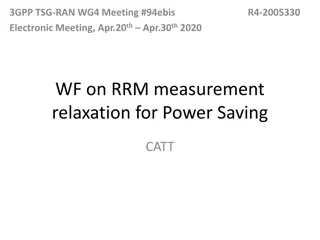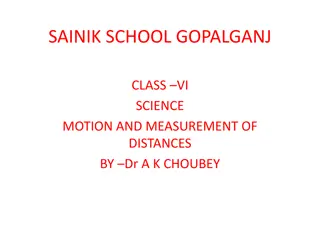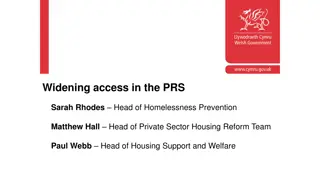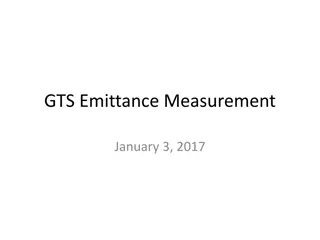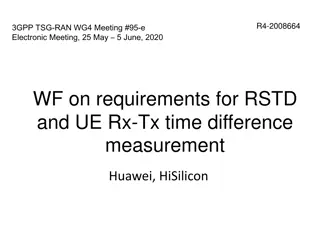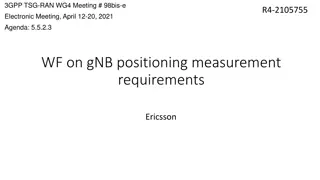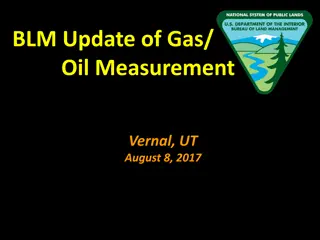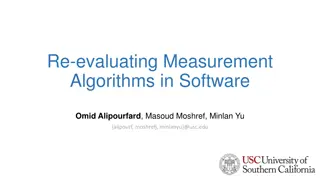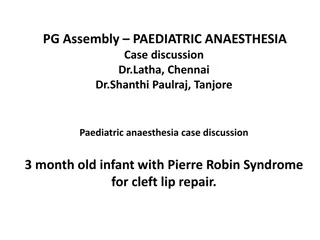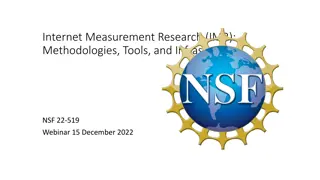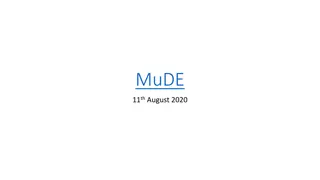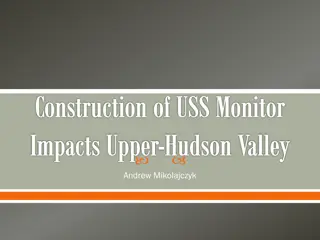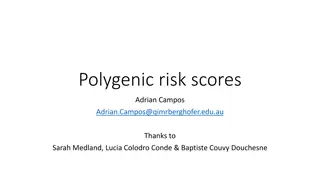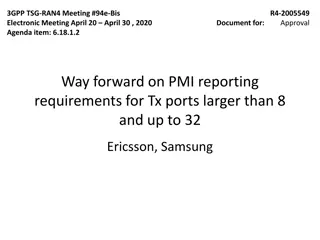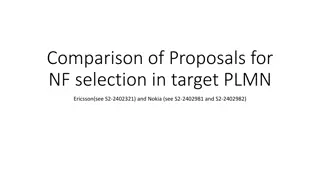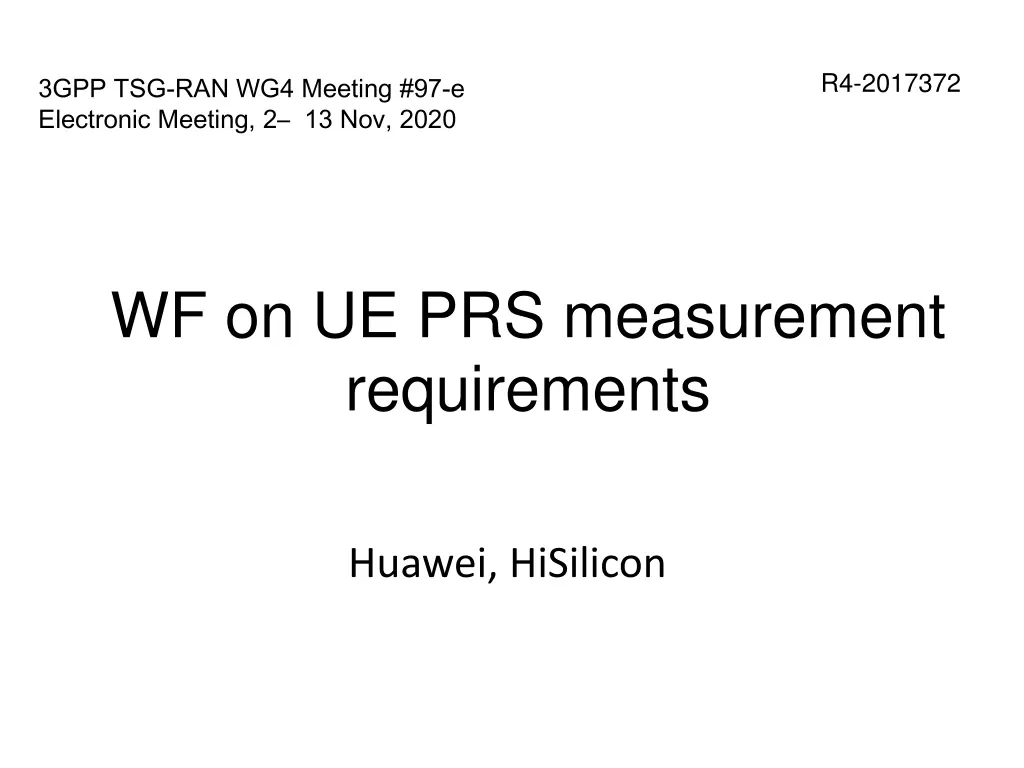
UE PRS Measurement Requirements for RSTD and SSB Collision
Discover the measurement period extensions for RSTD due to SSB collision, options for overlapping cases, open issues for discussion related to PRS sample duration calculation, and considerations for RSTD when configured with PRS-RSRP measurements.
Download Presentation

Please find below an Image/Link to download the presentation.
The content on the website is provided AS IS for your information and personal use only. It may not be sold, licensed, or shared on other websites without obtaining consent from the author. If you encounter any issues during the download, it is possible that the publisher has removed the file from their server.
You are allowed to download the files provided on this website for personal or commercial use, subject to the condition that they are used lawfully. All files are the property of their respective owners.
The content on the website is provided AS IS for your information and personal use only. It may not be sold, licensed, or shared on other websites without obtaining consent from the author.
E N D
Presentation Transcript
R4-2017372 3GPP TSG-RAN WG4 Meeting #97-e Electronic Meeting, 2 13 Nov, 2020 WF on UE PRS measurement requirements Huawei, HiSilicon
Measurement period for RSTD (1) Measurement period extension due to SSB collision Existing RSTD measurement period is defined for cases when PRS samples are not dropped. UE is allowed to extend the RSTD measurement period if one or more PRS samples are dropped due to SSB collision, but the exact value is not specified.
Measurement period for RSTD (2) Measurement period: Option 1 (sum-based for overlapping case) FFS: the need for explicit definition of TRSTD,i(imposes specific UE implementation particularly in the sum-based approach, which shall be avoided) FFS: how to choose 1 frequency layer FFS: the definition of PRS/RRM frequency layer when both PRS and RRM are configured on the same frequency layer FFS: the exact CSSF definition (different from Rel-15 CSSF concept) Option 2 (max-based for both overlapping and non-overlapping cases) ?????,?????= Maxi(?????,?) + Xlast CSSF is based on Rel-15 CSSF concept (i.e., all positioning layers are counted), no need to re-define k is added in ????,i ???? ????,i ? TPRS RSTD,i= CSSFPRS,i ???????,? ??????? 1 ? Teffect,i+ Tlast ? k=TBD, e.g., number of PRS frequency layers ( i) having their PRS (in another MG) within Tifrom the current MG when Ti< Tprs,i, otherwise k=1 FFS: rule for long-periodicity PRS measurements when 2 frequency layers have long Tprs
Measurement period for RSTD (3) Open issues to be discussed at RAN4#98-e Lprs definition in 38.133 Calculation of PRS sample duration Option 1: The calculation of PRS sample duration should be based on the type (type 1 or type 2) as UE used to report {N,T} Option 2: Do not agree with option 1. The sample parameters (e.g., number of repetitions, number of PRS symbols in slot, etc.) are to be defined in the accuracy requirements Multiple PRS periodicities Option 1: Use the maximum PRS resource periodicity among all PRS resources in a single positioning frequency layer Option 2: Use the least common multiple of PRS periodicities among all PRS resources in a single positioning frequency layer Option 3: In Rel-16, RAN4 requirements should apply only for PRS periodicities that are multiples of 5 ms Option 4: FFS, consider the case where e.g. not all PRS resources or resource sets are in gaps.
Measurement period for RSTD (4) Open issues to be discussed at RAN4#98-e Measurement period when configured with PRS-RSRP Option 1: RSTD measurement period shall not be impacted by PRS-RSRP measurement. Option 2: When RSTD is configured together with PRS-RSRP and the required PRS- RSRP measurement period is longer than that for RSTD (configured without RSTD), then the RSTD measurement continues over the entire PRS-RSRP measurement period Option 3: PRS-RSRP measurement period is the same as that for RSTD, while the accuracy requirements are met for both PRS-RSRP and RSTD. Consider the following two scenarios: Scenario 1: UE being configured to do DL-TDOA only Scenario 2: UE being configured to do both DL-TDOA and DL-AoD
Measurement period for RSTD (5) Open issues to be discussed at RAN4#98-e Measurement period of multiple PRS layers overlapping case Option 1 Measurement period of multiple PRS layers is defined as summation of the measurement period in each frequency layer CSSF is only for the MG sharing between PRS and RRM layers. Count only a single PRS layer for a gap occasion in CSSF calculation for both PRS and RRM layers. Option 2 CSSF is used for PRS measurements as for other NR measurements Measurement period TRSTD, Total = maxi (TRSTD,i). Measurement period of multiple PRS layers non-overlapping case Option 1: If such scenario is considered as a rare case, then adopt the sum approach; If such scenario is considered as a typical case, then adopt the max approach to reduce the measurement delay Option 2: Same requirements as for overlapping case (sum approach) Option 3: CSSF is used for PRS measurements as for other NR measurements. Measurement period for the non-sharing case shall be: TRSTD, Total = maxi (TRSTD,i)
Measurement period for PRS-RSRP (1) Measurement period extension due to SSB collision Follow the same conclusion for RSTD Measurement period of multiple PRS layers overlapping case Follow the same conclusion for RSTD. Measurement period of multiple PRS layers non-overlapping case Follow the same conclusion for RSTD. Measurement period of PRS-RSRP when configured with RSTD or UE Rx-Tx Follow the same conclusion for RSTD
Measurement period for UE Rx-Tx time difference (1) Measurement period extension due to SSB collision Follow the same conclusion for RSTD Measurement period when configured with PRS-RSRP Follow the same conclusion for RSTD Measurement period of multiple PRS layers overlapping case Follow the same conclusion for RSTD. Measurement period of multiple PRS layers non-overlapping case Follow the same conclusion for RSTD. SRS/PRS being in same band Option 2: Basic requirements for UE Rx-Tx time difference measurements shall be based on the assumption that positioning SRS resources are in the same band as PRS frequency layer
Measurement period for UE Rx-Tx time difference (2) Open issues to be discussed at RAN4#98-e Whether SRS periodicity should be accounted in measurement period Option 1: No Option 2: Yes, TUERxTx,Totalcan be extended if the SRS periodicity is longer than max(TPRS,i) Whether SRS dropping should be accounted in measurement period Option 1: No Option 3b: UE is allowed to extend the UE Rx-Tx measurement period (clarified in the requirements), but the exact value is not specified. Option 3c: The UE Rx-Tx requirements apply, regardless of how many SRS are dropped.
Measurement period for UE Rx-Tx time difference (3) Open issues to be discussed at RAN4#98-e SRS/PRS proximity Option 1: The measurement requirements are applicable only if any SRS transmission is within [-X, X] msec of at least one DL PRS resource of each of the TRPs in the assistance data. Accuracy requirements is independent of PRS and SRS separation. Option 1a: X=50ms Option 1b: X=160ms Option 1c: X=25ms Option 1d: X=80ms Option 2: The requirements for UE Rx-Tx apply regardless of the time separation between SRS and PRS (LTE approach) Option 3: The requirements for UE Rx-Tx apply provided MIN(Tsrs, Tprs) 2*X; X = FFS (we can accept X = 160 ms).
Measurement period for UE Rx-Tx time difference (4) Open issues to be discussed at RAN4#98-e Measurement period in case of TA change (due to TA command) Option 1: UE should continue Rx-Tx time difference measurement (existing requirements are applicable) Option 2a: UE shall discard the UE Rx-Tx time difference measurement if the uplink transmission timing (autonomous or based on network- configured TA) changes during the UE Rx-Tx measurement period Option 2b: UE Rx-Tx time difference measurement requirements are not applicable if TA change is received during the measurement period. Measurement period in case of TA change (due to UE autonomous adjustment) Option 1: UE should continue Rx-Tx time difference measurement (existing requirements are applicable) Option 2: UE shall discard the UE Rx-Tx time difference measurement if the uplink transmission timing (autonomous or based on network- configured TA) changes during the UE Rx-Tx measurement period Option 3: follow the same conclusion from sub-topic 3-10.
Measurement period for UE Rx-Tx time difference (5) Open issues to be discussed at RAN4#98-e Measurement period in case of NTA_offsetchange Option 1: No need to clarify UE Rx-Tx measurement requirements in case of NTA_offsetchange Option 2: It is clarified in UE Rx-Tx measurement requirements (section 9.9.4 in TS 38.133) that the UE shall discard the UE Rx-Tx measurement if the NTA_offsetchanges during the measurement period. UE Rx-Tx at cell change Option 1: The UE Rx-Tx time difference measurement is restarted if the serving cell (PCell, PSCell, or SCell) configured with the SRS for positioning changes during the measurement period. In this case, the UE shall restart the UE Rx-Tx time difference measurement after the SRS reconfiguration on the target cell is complete. Otherwise, the UE shall continue the on-going UE Rx-Tx time difference measurement after the serving cell change Other options not precluded
Measurement capability Open issues to be discussed at RAN4#98-e Applicability conditions related to measurement capability Option 1: The measurement requirements do not apply for a PRS resource, if time span of the PRS resource instance is greater than UE reported capability N. Option 2: The measurement requirements do not apply for a PRS resource, if the time span of a DL PRS resource instance is greater than the configured measurement gap length Option 3: The measurement requirements do not apply for a PRS resource, if the PRS resource is across two sampling duration of N within duration Lprs Option 4: none of option 1~3 is needed. It s already clear from 38.133 that the measurements are performed within the UE capability. Note: option 1~3 are not exclusive with each other
CSSF when configured with PRS measurement (1) Define CSSF based on the following principles unless technical issues are identified. In case PRS measurement in the positioning frequency layer is considered as a long periodicity measurement, then the CSSF for this frequency layer is equal to one Exact definition and criteria for long periodicity PRS measurements are FFS Otherwise the positioning frequency layer would compete for MG with other gap-based RRM and/or PRS measurements from other frequency layers Option 1: frequency layer would compete for MG with other gap- based RRM measurements Option 2: frequency layer would compete for MG with other gap- based RRM and PRS measurements
CSSF when configured with PRS measurement (2) Open issues to be discussed at RAN4#98-e Condition of long periodicity PRS measurement Option 1a: Tprs * X * dl-prs-MutingBitRepetitionFactor >=160ms X is the number of consecutive zeros in NR-MutingPattern-r16 for mutingOption1-r16 Option 1b: max(Tprs * X * dl-prs-MutingBitRepetitionFactor) >=320ms X is the length of NR-MutingPattern-r16 for mutingOption1-r16 Option 1c: Tprs * X >=320ms X is the size of MutingPattern Option 1d: Long-periodicity NR measurements are the measurements with PRS periodicity >160 ms (with or without muting) or equal 160 ms (with muting) Option 2: Long-periodicity PRS means the PRS periodicity in each frequency layer defined in sub-topic 1-2 is larger than or equal to [320]ms Option 3: FFS Different resource periodicities in a PRS layer Option 1: For position frequency layers, calculate ???????,?based on the maximum periodicity across all the PRS resources within each layer and taking into account type1 (inter-period) muting Option 1a: Follow the same conclusion of sub-topic 1-2 Option 2: Not needed. We should take the per-gap approach, as it is in Rel-15. Option 3: FFS FFS whether and how muting should be accounted in the PRS measurement period requirements as captured in TS 38.133 sections 9.9.2, 9.9.3 and 9.9.4

